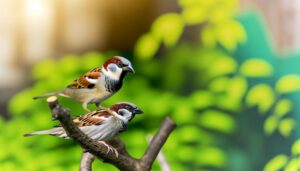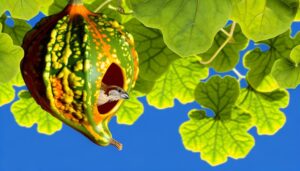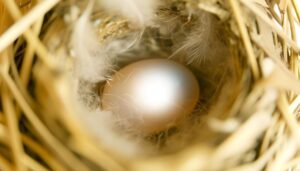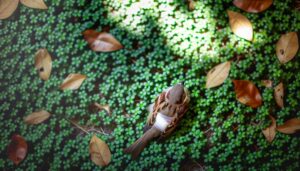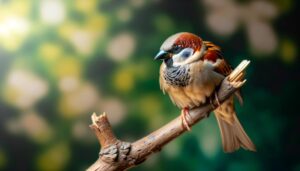7 Simple Steps to Make a Cardboard Sparrow House
Creating a cozy sparrow house from cardboard is an enjoyable, eco-friendly project. Start by gathering high-quality, corrugated cardboard, a ruler, pencil, sharp utility knife or scissors, non-toxic glue, and masking tape.
Design the house with a blueprint that includes a 1.5-inch entry hole, ventilation, and drainage holes. Measure and cut the cardboard precisely for the front, back, sides, roof, and base.
Assemble by aligning and securing pieces with glue, ensuring there are no gaps. Let the glue set before adding a water-resistant sealant.
Decorate with earthy tones, attach a perch, and add natural elements. Follow these steps to create a sparrow-friendly home.

Key Takeaways
- Sketch a blueprint with dimensions, including a 1.5-inch entry hole, ventilation, and drainage holes.
- Measure and cut cardboard pieces for front, back, sides, roof, and base using a ruler and sharp utility knife.
- Securely glue and align the pieces, ensuring a solid frame and proper pressure until the glue sets.
- Seal the exterior with water-resistant sealant and paint in earthy tones for durability and aesthetics.
- Add a small perch near the entrance and decorate with twigs and leaves to make the house inviting.
Materials Needed
Gathering the necessary materials is the first step in constructing a durable and safe sparrow house using cardboard.
Begin by acquiring high-quality, corrugated cardboard, known for its strength and durability. You will also need a ruler for precise measurements, a pencil for marking, and a sharp utility knife or scissors for cutting.
Reinforce the structure with non-toxic glue, ensuring the safety of the birds. Masking tape can be useful for holding pieces together temporarily.
Additionally, gather some waterproof paint or a sealant to protect the cardboard from moisture. Finally, have some sandpaper on hand to smooth out any rough edges.
With these materials prepared, you'll be well-equipped to create a secure and inviting home for sparrows.
Designing the House
With all the necessary materials at hand, the next step involves drafting a detailed design for the sparrow house to guarantee it meets the birds' needs and provides a sturdy structure.
Begin by sketching a simple blueprint. Consider the following essential elements:
- Dimensions: Make sure the house is large enough for sparrows but small enough to remain cozy.
- Entry Hole: A circular opening approximately 1.5 inches in diameter is ideal.
- Ventilation: Design small holes for air circulation to keep the interior fresh.
- Drainage: Incorporate small holes at the bottom for water to escape.
Cutting the Cardboard
Carefully measure and mark the cardboard according to your blueprint, making sure that each segment is accurately outlined before making any cuts. Use a ruler for precision and a pencil for clear, erasable lines. Begin by identifying all the pieces needed for the sparrow house: the front, back, sides, roof, and base.
Double-check measurements to verify they align perfectly. Employ a sharp utility knife or a pair of sturdy scissors for cutting. Maintain steady pressure and follow the marked lines closely to achieve clean edges. For safety, work on a cutting mat or a similar protective surface.
Assembling the Pieces
Begin the assembly by aligning the front and back pieces of the cardboard structure, guaranteeing their edges meet seamlessly. Secure these pieces together using a strong adhesive, such as hot glue or craft glue.
Next, attach the side panels one at a time to create a solid frame. Make sure that each joint is firmly bonded to avoid instability.
Apply glue to the edges: Guarantee an even application to prevent gaps.
Hold pieces in place: Maintain pressure until the glue sets.
Check alignment: Use a ruler to confirm straight edges.
Reinforce joints: Add extra glue if necessary for additional strength.
Adding Final Touches
Once the frame is securely assembled, it is time to personalize and protect your sparrow house by adding final touches. Begin by applying a non-toxic, water-resistant sealant to the exterior for durability. Next, paint the house in earthy tones to blend with the environment. Add a small perch near the entrance for sparrows to land on. Lastly, decorate with natural elements like twigs and leaves to make it more inviting.
| Task | Materials Needed | Instructions |
|---|---|---|
| Seal the exterior | Non-toxic water-resistant sealant | Apply evenly over all external surfaces |
| Paint the house | Earth-toned paint | Use a brush to cover the exterior uniformly |
| Add a perch | Small wooden dowel | Attach near the entrance using glue |
| Decorate with elements | Twigs, leaves | Glue or attach around the house aesthetically |
Conclusion
To sum up, constructing a sparrow house with cardboard offers a rewarding and eco-friendly project. By carefully selecting materials, designing the house, accurately cutting the cardboard, and meticulously assembling the pieces, a sturdy and inviting home for sparrows is created. Adding final touches enhances both the aesthetic and functionality of the birdhouse.
Is there a more gratifying way to contribute to local wildlife and promote environmental sustainability? This project not only benefits sparrows but also fosters a sense of accomplishment.

